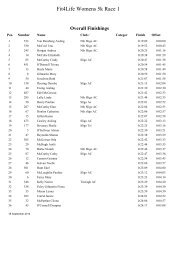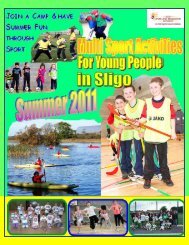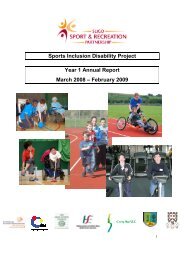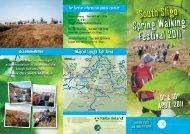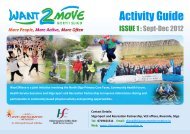Girls Active Programme - Sligo Sport and Recreation Partnership
Girls Active Programme - Sligo Sport and Recreation Partnership
Girls Active Programme - Sligo Sport and Recreation Partnership
You also want an ePaper? Increase the reach of your titles
YUMPU automatically turns print PDFs into web optimized ePapers that Google loves.
Findings<br />
4.1 Questionnaire<br />
A total of 198 girls who participated on <strong>Girls</strong><br />
<strong>Active</strong> during the school year of 2004-5 returned<br />
completed questionnaires. These came from 18<br />
out of the 19 schools that took part in that year<br />
<strong>and</strong> represented approximately 60% of the total<br />
number of girls involved.<br />
potential benefits of being active. Their responses<br />
are provided in Fig. 2 <strong>and</strong> indicate that the vast<br />
majority of girls are aware of at least some of the<br />
benefits of physical activity.<br />
Fig.2 - Benefits of Physical Activity<br />
(PA= Physical Activity)<br />
While limited to Phase Two, the survey gathered data<br />
from a wide range of schools <strong>and</strong> a considerable<br />
proportion of the girls who participated. It is<br />
suggested, therefore, that the survey findings<br />
reflect a representative cross-section of the<br />
perceptions of girls on their experience of the <strong>Girls</strong><br />
<strong>Active</strong> programme during that year, especially<br />
when considered in conjunction with the findings<br />
from the focus group discussions (Section 4.2)<br />
4.1.1 Age & Class Group<br />
Respondents varied in age from 12yrs to 17yrs<br />
when they participated on <strong>Girls</strong> <strong>Active</strong> during<br />
2004/5. The average age was 14.7yrs (Fig. 1).<br />
Fig.1 - Age of Respondents<br />
Every class group from 1st year to 6th year were<br />
represented in the sample 15 . The most common<br />
class group taking part were 4th years (transition<br />
years, 30% of the total), 2nd years (27%) <strong>and</strong><br />
5th years (23%). More than half of participants,<br />
therefore, were in senior cycle when they took part<br />
in <strong>Girls</strong> <strong>Active</strong>.<br />
4.1.2 Awareness Of Benefits Of Physical<br />
Activity<br />
Respondents were asked whether they agreed or<br />
disagreed with a series of statements relating to the<br />
Over 80% agreed or strongly agreed that<br />
physical activity helps them to feel better <strong>and</strong> over<br />
70% agreed or strongly agreed that they enjoy<br />
physical activity <strong>and</strong> that it gives them a feeling<br />
of achievement. A majority (64%) also agreed or<br />
strongly agreed that physical activity helps them to<br />
look better. A smaller but still notable proportion<br />
of respondents (about 50%) agreed or strongly<br />
agreed that physical activity helps them to make<br />
friends <strong>and</strong> to concentrate better.<br />
4.1.3 Social Personal & Health Education<br />
<strong>Programme</strong><br />
Of the 78% of respondents who had a timetabled<br />
SPHE class 16 more than two-thirds (68%) reported<br />
that physical activity was discussed during the<br />
class.<br />
4.1.4 Motivation To Participate<br />
When asked to identify the MAIN reason why they<br />
participated in <strong>Girls</strong> <strong>Active</strong>, the majority of girls<br />
12<br />
Evaluation of the <strong>Girls</strong> <strong>Active</strong> <strong>Programme</strong> - 2003 – 2005 Report



